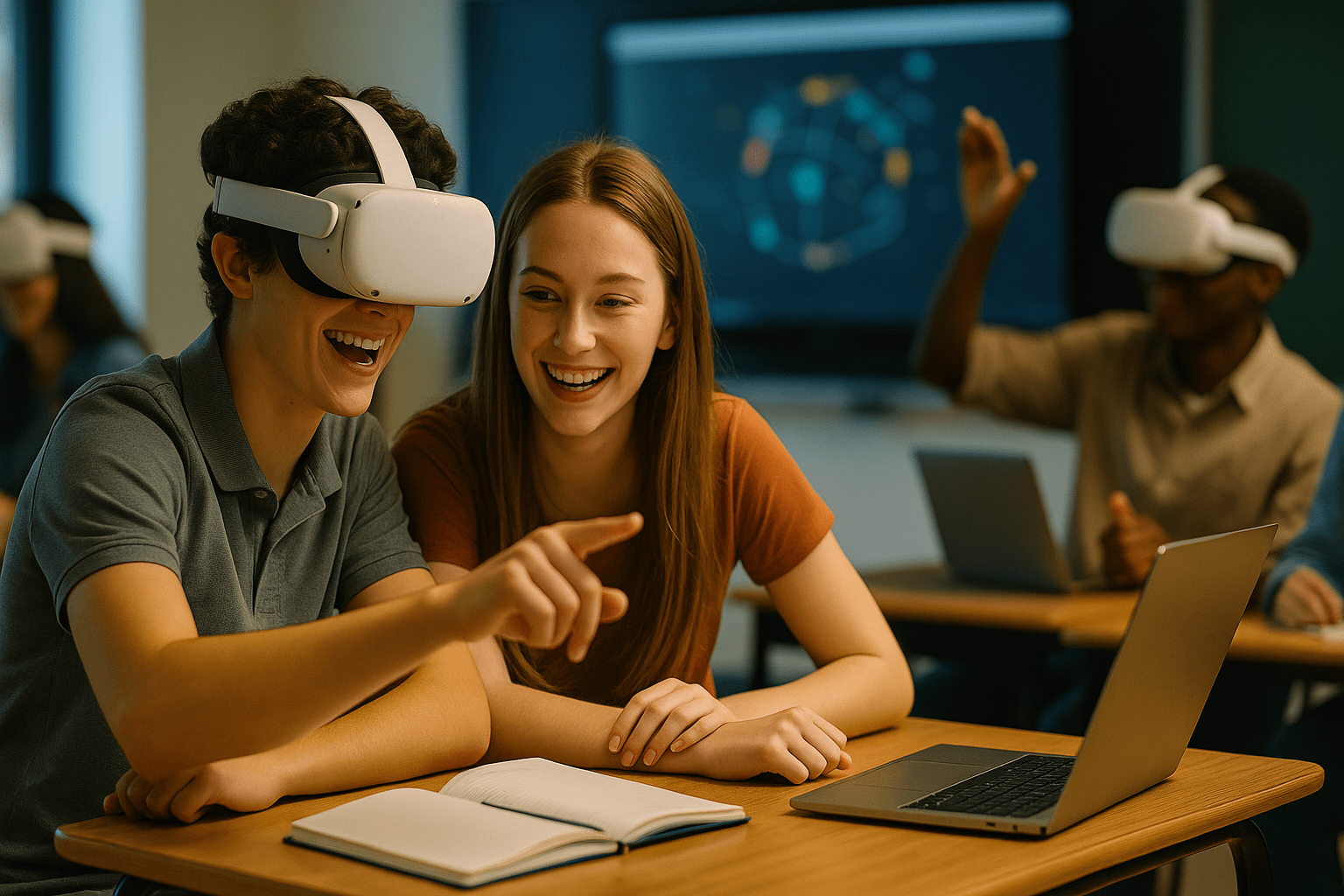The Real Impact of AI on Education and How It’s Reshaping the Way We Learn
It’s not just chatbots and essay-writing tools-artificial intelligence (AI) is rapidly changing how students engage with learning, how teachers design instruction, and how institutions manage their operations. Understanding the impact of AI on education isn’t just useful-it’s essential for anyone involved in teaching, learning, or tech strategy within schools and universities.
At Pukunui Sdn Bhd, we work closely with institutions across the region implementing platforms powered by the Moodle™ software. We’ve seen firsthand how AI tools affect both learners and educators. In this blog post, we’ll unpack the real-world impact of artificial intelligence in the field of education, explore the pros and cons, and offer practical insights you can take away and apply. As we delve into this topic, it’s essential to recognize how AI integration is transforming the educational landscape. With the advent of smarter classrooms with AI integration, both teaching methodologies and learning experiences are becoming more personalized and efficient. Additionally, we will highlight case studies that showcase the successful adoption of these technologies in various educational settings.
Personalized Learning Isn’t the Future – It’s Already Here
Let’s start with something big: AI in education has already transformed one of the oldest challenges in teaching-how to adapt to each learner’s pace and style. Thanks to machine learning algorithms, we’re seeing platforms that personalize learning experiences in real-time. These advancements are not only enhancing engagement but also enabling educators to focus on facilitating deeper understanding among students. Additionally, the integration of virtual reality in education allows learners to immerse themselves in interactive simulations, making complex concepts more accessible and memorable. As these technologies evolve, the potential for transformative learning experiences continues to grow, paving the way for a more individualized and effective educational landscape.
When students work on Moodle™-based platforms connected to AI-powered tools, the system can tailor the content based on past performance, preferred formats (videos vs. text), even interests tracked across topics. Teachers now get analytics that flag struggling students long before an exam brings bad news.
Here’s what that looks like in action:
- Adaptive quizzes that serve different questions based on student responses
- Automated feedback delivered instantly after submissions-saving teachers hours
- Intelligent content recommendations based on gaps or strengths in prior learning
Now, AI can’t yet read a student’s face to tell if they’re confused-but it’s getting close.
AI Tools That Are Already in the Classroom
It’s one thing to talk about future applications. The real question is: what AI-powered tools are already being used by educators?
Here are examples of common AI tools educators are incorporating today:
- Writing assistants like Grammarly or tools integrated into LMS platforms to give feedback on clarity and grammar
- Speech-to-text and voice-controlled learning interfaces for students with accessibility needs
- AI tutors and chatbots that answer 24/7 homework questions in real-time, giving Mums and Dads everywhere a break
Not only do these AI systems free up teacher time, but they also create a smoother learning experience for students, making remote and hybrid learning far more viable than ever before. Moreover, as educators increasingly adopt innovative technologies, the integration of AI with existing platforms enhances personalized learning paths tailored to individual student needs. This shift aligns well with learning management system trends 2023, which emphasize adaptive learning and analytics to improve educational outcomes. Ultimately, the convergence of these advancements paves the way for more engaging and effective teaching methods.
Advantages of AI in Education That Actually Matter
You’ve probably heard that AI can make things “smarter” or “more efficient.” Those phrases are everywhere. But here’s what that actually means on the ground for schools:
- Streamlined grading: AI can mark multiple-choice questions and provide instant scoring for assignments with rubrics
- Reduced admin strain: Scheduling, messaging, and content management can all be automated
- Better insights: Machine learning dives into student data to spot patterns no human observer can catch easily
- Time for mentorship: Teachers focus less on logistics, more on human interaction and guidance
- Customized pathways: Students struggling with algebra but flying through geometry? AI can adjust course emphasis accordingly
One caveat:
Don’t expect AI to solve every problem. It’s a tool, not a teacher, and we still need the human touch (especially when things go very… non-linear. Like group projects.)
Where It Goes Wrong: Disadvantages of AI You Shouldn’t Ignore
The impact of AI in education isn’t all positive. While there’s plenty of buzz about the upsides, smart educators are thinking critically about the risks, too. Here are concerns that keep popping up in faculty meetings:
- Equity: Advanced AI technologies can be expensive. Not all schools have the resources to purchase or maintain them.
- Over-standardization: Over-reliance on algorithms might push everyone into a similar learning pathway, stifling creativity.
- Job displacement: Will AI tools replace teachers or change their roles so drastically that some positions become obsolete?
- Data privacy: Sensitive student data is being processed. What protections are in place?
- The illusion of understanding: AI-powered summarizers can give students answers without making them think. Learning doesn’t happen by copy and paste.
So yes, AI can help. But blind adoption? That’s not smart.
Generative AI in the Learning Environment
Generative AI-tools like ChatGPT, DALL·E, or AI-driven video explainers-introduce both new learning modes and new ethical challenges. You might think of them as the overachievers in the AI class: energetic, creative, and occasionally too confident for their own good.
Here’s why generative AI matters in a learning environment:
- Students use it… whether you endorse it or not. Teaching ethical, effective use is better than forbidding it outright.
- You can generate first drafts for lesson plans, content summaries, quiz questions-significantly reducing prep time.
- Visual learning is enhanced: Generative AI can create diagrams, illustrations, or video content in seconds.
Our tip? Introduce assignments that require AI use and make students explain or critique the outputs. It builds higher-order thinking.
Does AI Replace Teachers?
You’ve heard the rumors: robot teachers, AI principals, smart campuses running themselves. Let’s be real-none of that works without humans setting the course.
What AI offers is augmentation, not automation. Think of it as a digital teaching assistant that never sleeps. Educators still:
- Decide on pedagogy and philosophy
- Interpret and contextualize student performance data
- Guide emotional and interpersonal learning
- Teach critical reasoning-what if the AI result is wrong?
So far, AI systems can’t make sense of a student’s silence, notice a mental health flag, or coach through a messy group dynamic. For those tasks, educators remain irreplaceable.
How Moodle™ Platforms Fit in the AI Conversation
We work with the Moodle™ software as a core part of our solution architecture. Its openness allows clients to experiment, connect to external AI applications, and build productive workflows tailored to their students’ needs.
Some things Pukunui clients have achieved using Moodle™ software together with AI tools:
- Automated learning pathways for induction training
- SMART dashboards that flag disengagement in online modules
- Integrated chatbots for student support and FAQs
Want to brainstorm how Moodle™ integrations could transform your digital campus? Contact us for a consultation.
AI Helps, But Institutions Must Lead With Strategy
If you’re thinking of embracing AI in education, pause before adopting flashy tools. Start with intentions-what specific problems are you trying to solve?
Here’s a strategic adoption checklist:
- Define clear use cases (e.g., boost engagement, identify at-risk students, assist special education)
- Map out privacy and data policies aligned with local regulations
- Train staff from a pedagogy-first perspective, not a tech-first
- Start small: pilot and refine over time
- Include students in the conversation – they’ll be your best testers and critics
The role of artificial intelligence shouldn’t be system-wide replacement-it should be thoughtful supplementing of existing practices
How the Future of Education Will Be (Partly) Powered by AI
The near-future classroom won’t be unrecognizable-but it will definitely be smarter.
Expect to see developments like:
- AI-driven diagnostics that predict student success or risks before a semester begins
- Hyper-personalised career pathing mapped to student strengths and current labor trends
- Language-learning bots that provide feedback in Mandarin, Spanish, or Swahili at 3 AM
- Holistic learning analytics across offline and online interactions
People often ask, “Will AI change everything?” Our answer is no. It’ll change some things in big ways, and many things in smaller but still important ways. The trick is keeping humans at the center of those changes.
FAQs About impact of ai on education
What is the impact of artificial intelligence on education?
AI has significantly transformed education by enabling personalized learning, streamlining administrative tasks, and expanding access to learning materials. With real-time feedback, adaptive assessments, and curriculum recommendations, AI supports both students and teachers. However, these benefits come with concerns about cost, equity, and potential over-reliance on technology. Furthermore, the integration of AI in education encourages educators to examine their methods and approaches, leading to rethinking learning analytics approaches. By leveraging data more effectively, schools can better identify student needs and tailor interventions accordingly. Ultimately, striking a balance between technology and traditional teaching methods will be crucial in maximizing the benefits of AI while addressing its challenges.
Does AI have a positive impact on education?
Yes, AI offers a range of positive impacts in education. It helps tailor instruction to different learning styles, automates repetitive tasks for teachers, provides engaging learning tools for students, and improves early detection of learning challenges. The key is implementing AI ethically and strategically to support-not replace-traditional teaching methods.
Key Takeaways and What You Can Do Next
- AI isn’t a silver bullet – but used well, it’s a powerful support tool.
- Personalization is one of AI’s strengths. Use it to tailor content and pace.
- Teachers are essential. AI might help them, but it can’t replace their insight, empathy, or experience.
- Privacy and access must be planned for, especially in underfunded communities.
- Pukunui can help you build smart systems based on Moodle™ software and supported by thoughtful AI integrations.
Want to see how AI can enhance your Moodle™-based learning environment? Get in touch with us at Pukunui Sdn Bhd to set up a consultation or demo.

